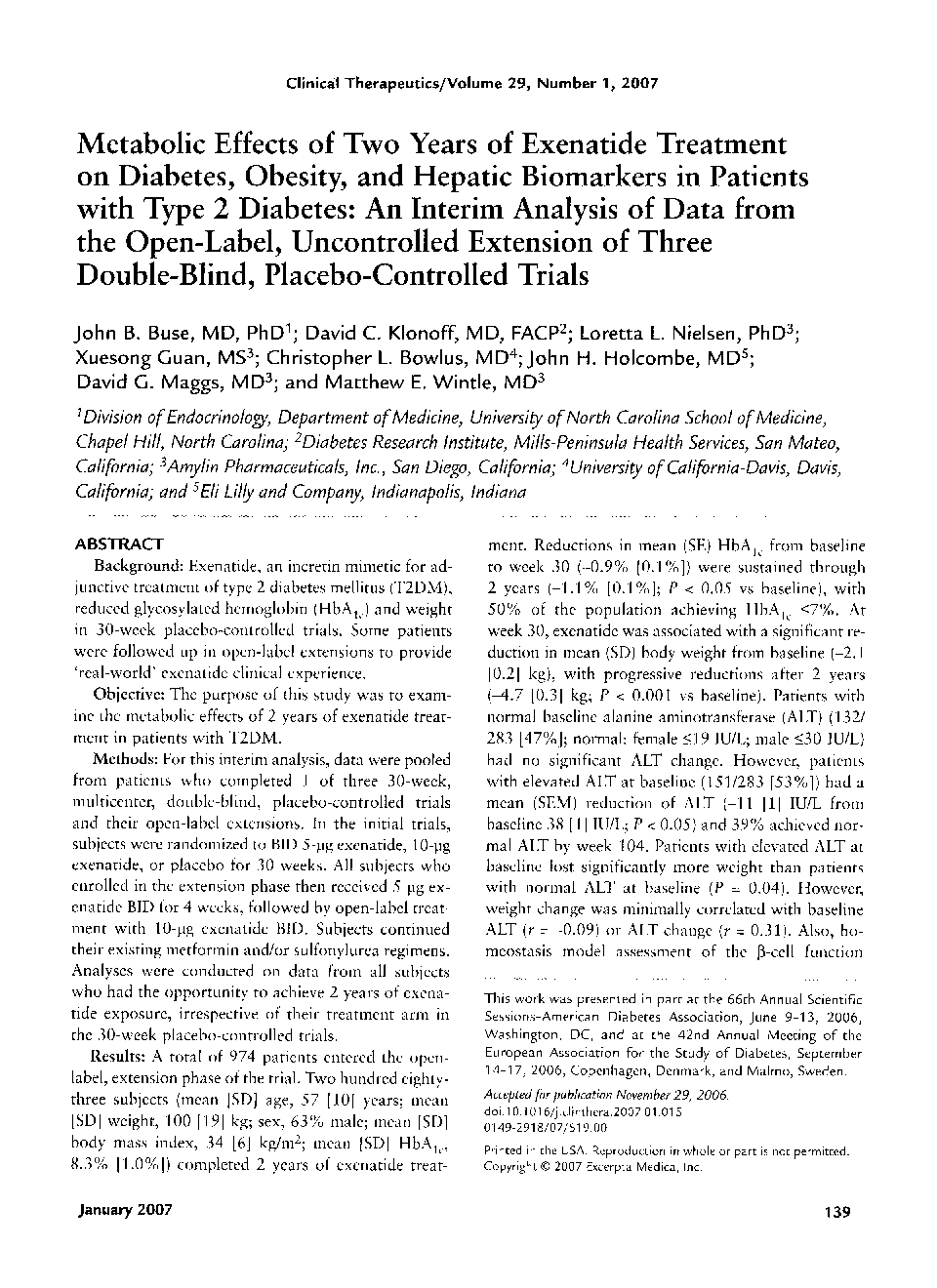| کد مقاله | کد نشریه | سال انتشار | مقاله انگلیسی | نسخه تمام متن |
|---|---|---|---|---|
| 2528850 | 1119989 | 2007 | 15 صفحه PDF | دانلود رایگان |

Background:Exenatide, an incretin mimetic for adjunctive treatment of type 2 diabetes mellitus (T2DM), reduced glycosylated hemoglobin (HbA1c) and weight in 30-week placebo-controlled trials. Some patients were followed up in open-label extensions to provide ‘real-world’ exenatide clinical experience.Objective:The purpose of this study was to examine the metabolic effects of 2 years of exenatide treatment in patients with T2DM.Methods:For this interim analysis, data were pooled from patients who completed 1 of three 30-week, multicenter, double-blind, placebo-controlled trials and their open-label extensions. In the initial trials, subjects were randomized to BID 5-pg exenatide, 10-pg exenatide, or placebo for 30 weeks. All subjects who enrolled in the extension phase then received 5-pg exenatide BID for 4 weeks, followed by open-label treatment with 10-pg exenatide BID. Subjects continued their existing metformin and/or sulfonylurea regimens. Analyses were conducted on data from all subjects who had the opportunity to achieve 2 years of exenatide exposure, irrespective of their treatment arm in the 30-week placebo-controlled trials.Results:A total of 974 patients entered the open-label, extension phase of the trial. Two hundred eighty-three subjects (mean [SD] age, 57 [10] years; mean [SD] weight, 100 119 kg; sex, 63% male; mean [SD] body mass index, 34 [6] kg/m2; mean [SD] HbA1c, 8.3% [1.0%1] completed 2 years of exenatide treatment. Reductions in mean (SE) HbA1c from baseline to week 30 (−0.9% [0.1%]) were sustained through 2 years (−1.1% [0.1%]; P < 0.05 vs baseline), with 50% of the population achieving HbA1c ≤ 7%. At week 30, exenatide was associated with a significant reduction in mean (SD) body weight from baseline (−2.1 [0.2] kg), with progressive reductions after 2 years (−4.7 [0.3] kg; P < 0.001 vs baseline). Patients with normal baseline alanine aminotransferase (ALT) (132/283 [47%]; normal: female ≤19 IU/L; male ≤30 IU/L) had no significant ALT change. However, patients with elevated ALT at baseline (151/283 [53%]) had a mean (SEM) reduction of ALT (−11 [1] IU/L from baseline 38 [1] IU/1,; P < 0.05) and 39% achieved normal ALT by week 104. Patients with elevated ALT at baseline lost significantly more weight than patients with normal ALT at baseline (P = 0.04). However, weight change was minimally correlated with baseline ALT (r = −0.09) or ALT change (r = 0.31). Also, homeostasis model assessment of the β-cell function (HOMA-B), blood pressure, and aspartate aminotransferase (AST) all improved. The most frequently reported adverse event was mild-to-moderate nausea. Conclusions: In these patients with T2DM, adjunctive exenatide treatment for 2 years was generally well tolerated and resulted in a sustained reduction of HbA1c, progressive reduction in weight, and improvements in HOMA-B, blood pressure, and the hepatic injury biomarkers, AST and ALT.
Journal: Clinical Therapeutics - Volume 29, Issue 1, January 2007, Pages 139-153